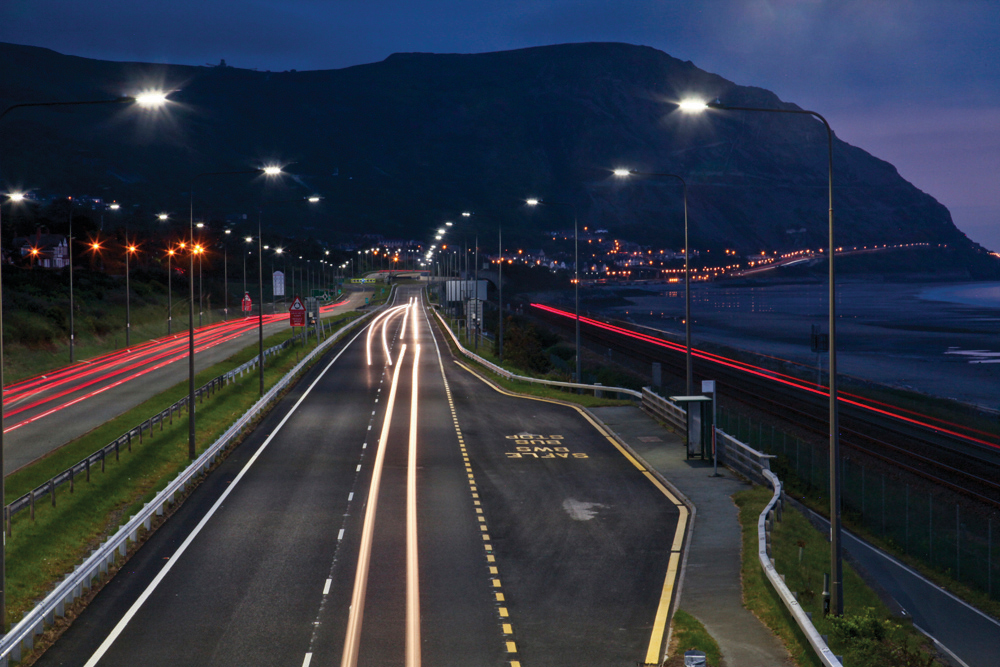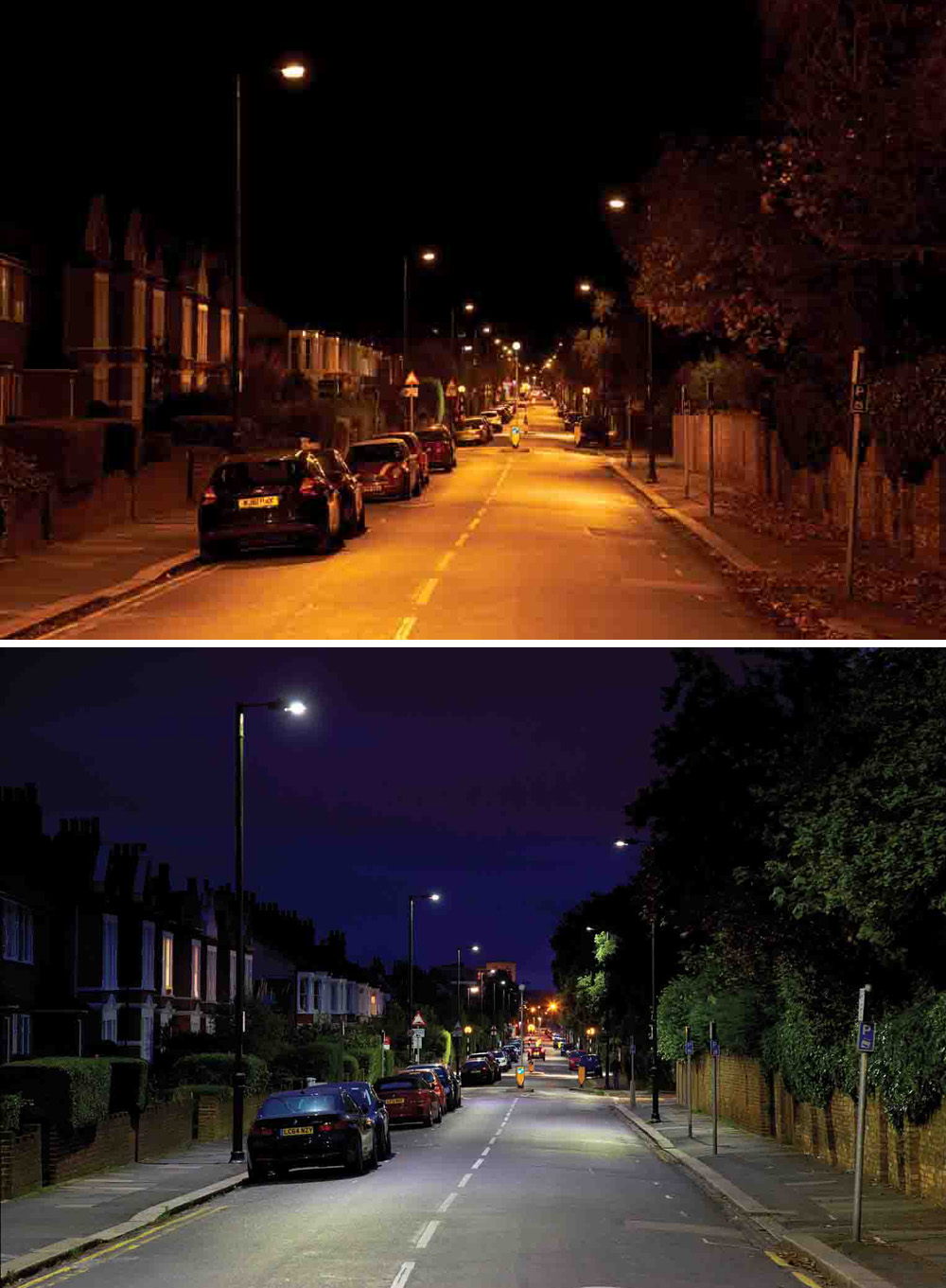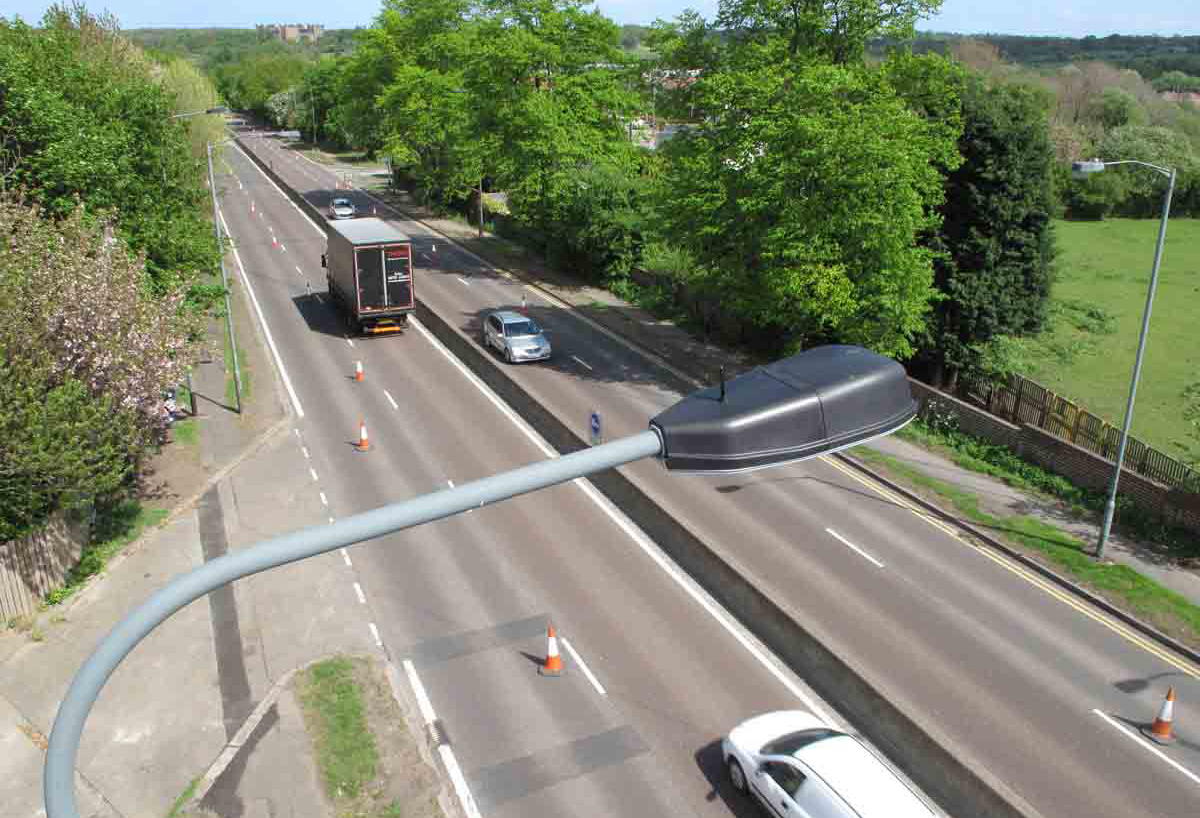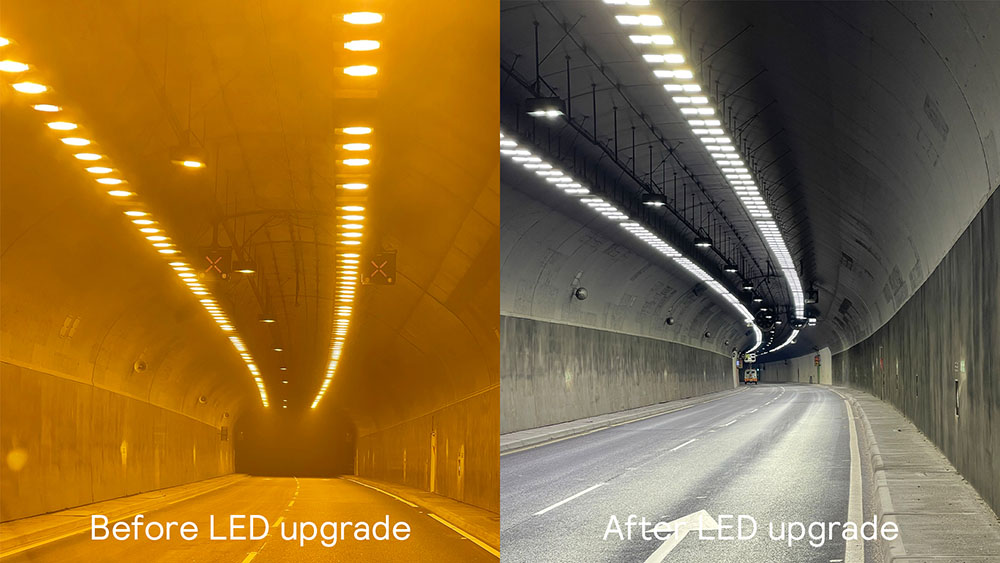CU Phosco’s new P850 LED main road lantern has just seen its first major deployment – between Junctions 16 and 17 of the A55, a strategic road which skirts the North Wales coastline – Jason Barnes reports The A55 is a grade-separated dual carriageway also known as the North Wales Expressway. Some 139km long, it originally ran from Chester to Bangor but was extended across the Isle of Anglesey into Holyhead Docks in 2001 under a project part-funded by the European Union.

The A55 North Wales Expressway presents lighting and other infrastructure engineers with a challenging operational environment
CU Phosco’s new P850 LED main road lantern has just seen its first major deployment – between Junctions 16 and 17 of the A55, a strategic road which skirts the North Wales coastline – Jason Barnes reports
The A55 is a grade-separated dual carriageway also known as the North Wales Expressway. Some 139km long, it originally ran from Chester to Bangor but was extended across the Isle of Anglesey into Holyhead Docks in 2001 under a project part-funded by the European Union. In a European context, the A55 is also a part of the Trans-European Road Network, forming a section of Euroroute 22. Holyhead is the westernmost point of a strategic trading route which passes from Wales via England and the Netherlands into Germany and Scandinavia, and eventually terminates in Ishim, Russia.
Along its route, lighting and other road infrastructure has to exist in a challenging environment. The A55 skirts the North Wales coastline for significant amounts of its Total length, so severe weather during winter months and corrosive marine conditions are common. Some sections of the existing lighting solution have been in operation for well over two decades and in places are in a very poor state of repair. Environmental conditions are not the only factor with which local infrastructure managers have to contend. The A55 carries significant holiday traffic in the summer as well as being a major trade route year-round, making the introduction of traffic management schemes for maintenance purposes difficult. This meant that although luminaires were in theory subject to a three-year change-out period, some had been allowed to burn to extinction without being replaced.
In January 2013, subsequent to a Contractor Framework tender, a design team from7595 CU Phosco was appointed and briefed to carry out a carbon reduction assessment across over 28km of illuminated carriageway of the A55. The assessment included 10 junctions in Total – from J13 to J23. The area for review is grade-separated for its entire length with the exception of two roundabouts, J15 at Llanfairfechan and J16 at Penmaenmawr, and the project’s key objectives were the realisation of energy, carbon and cost savings. With local conditions in mind, any proposed lighting solution had to demonstrate robustness as well as a very low maintenance burden.
An invest-to-save model was pursued and CU Phosco proposed three options as part of efforts to demonstrate best value during the project’s economic assessment phase. The first was a like-for-like replacement with SON-T 250W discharge lighting, the second was replacement of existing discharge lighting technology with a reduced, 150W discharge lighting solution and the third was an LED-based solution using CU Phosco’s new P850 main road luminaire. A total cost of ownership and payback period calculation was completed to illustrate the initial investment compared with the energy and maintenance costs and savings.
Analysis showed that the like-for-like replacement solution would have offered no material gain over that which had preceded it, whilst the 150W solution proved unable to meet the stipulated lighting classes – ME2 at peak times, and ME3a during periods of low traffic flow. In contrast the newer, LED-based solution using the P850 was able to meet the required lighting classes while offering significant improvements in a number of areas.
In April 2013, the North & Mid Wales Trunk Road Agent (NMWTRA – a partnership of eight local authorities with responsibility for managing on behalf of the Welsh Government a series of trunk roads, road infrastructure and road services) opted to change the system. NMWTRA took advantage of the introduction of traffic management measures as a part of the Penmaenmawr to Dwygyfylchi Major Maintenance Scheme to an upgrade of the lighting scheme on both carriageways of the stretch of road between Junctions 16 and 16A of the A55. Shortly after, it was decided to take further advantage of the in-place traffic management measures and extend this first-stage lighting refurbishment to Junction 17. The roadway maintenance contract was awarded to Dawnus Construction, which in turn let the lighting upgrade work to Conwy County Borough Council.
NMWTRA elected to retain the existing lighting columns and brackets, so the specification was for a lightweight, low wind area luminaire providing lighting to class ME2/ME3a at the existing column spacings. In addition to its lighting performance, the P850’s IP66 rating, wind area (SCx) of 0.052m2 and low unit weight (15kg or less, depending on configuration) made it an ideal choice.
Dimming to ME3a between midnight and 6am would be via a Telensa Central Management System (CMS). The CMS also contributes to energy savings and provides operators with the ability to provide accurate audits of energy usage. It has a further road safety function and was stipulated for the A55 project in order to address a specific need linked to ferry and road freight operations out of Holyhead. Although the lighting is dimmed during quiet periods at night, there are regular peaks of heavy traffic from 3.00-3.30am. The Telensa CMS allows office-based staff at NMWTRA to increase luminance as necessary. It communicates wirelessly with the newly installed P850s via nodes installed in the tops of the luminaires and can, dependent upon range, communicate with thousands of units. A sophisticated and expensive piece of equipment, it nevertheless has to be viewed in the context of energy savings over the total lifecycle of the new deployment.
LED luminaires’ inherent flexibility enables lighting scheme designers to tune a solution to an environment rather than just use brute power to achieve a desired result. To meet the local luminosity requirements on the A55 project, the previous 250W lamps had been working at 302W in circuit, however using LED technology it was possible to provide the necessary light uniformity and meet the ME2/ME3a standard using a combination of 166, 190 and 211W luminaires.
On the J16-17 deployment this has resulted in impressive energy reductions: a 38% saving when operating at ME2; and a 60% saving when operating at ME3a. The result is a calculated payback period of 4.2 years on an investment which included 348 lanterns, associated CMS dimming and remote monitoring.
The use of a limited number of versions of the P850 benefited the installation contractor by simplifying the ordering, delivery, storage and picking for installation processes but thereafter, with an anticipated 100,000 hours of burning time, the LED solution can be expected to operate without maintenance for around 24 years.
The new lighting solution for the J16-17 section of the A55 went into operation on April 26 this year, following a two-week installation period. All work was completed on time. Further upgrades to the lighting on other sections of the road will take place over the next two years as and when funding becomes available, and will further increase the numbers of the new P850 luminaire deployed on the UK’s roads.
New lantern technology
The P850 LED main road luminaire was introduced at the beginning of 2013 and the A55 is the largest single deployment to date. The P850 has been designed to combine outstanding heat management, optical performance and energy saving with pleasing, slimline aesthetics. Thermal management is a key requirement for any solid-state lighting technology and the outer rim and vertical fins of the P850’s casing form the AeroFlow cooling system.
This registered trademarked solution is designed to accelerate natural convection through the luminaire’s heat sink. Rising hot air draws cold air in from the bottom, the exiting air converging into a smooth laminar flow which quickly removes heat. Standard neutral white LEDs (CCT = 4,000K / CRI > 70) and high-efficiency reflectors result in improved mesopic vision and exceptional uniformity; the P850 is dark sky-friendly, with zero upward light and features minimal glare (a G6 rating is achieved when installed with a 0o tilt). The unit’s 36 Philips Luxeon M LEDs consume 88-300W, depending on configuration, and a luminaire efficacy of up to 111lm/W is offered. All of this comes in a high-pressure die-cast aluminium housing (Marine Grade 6) with vandal-resistant, toughened glass.
Although LEDs have been used in street lighting for some years now, CU Phosco initially stayed its hand, preferring to monitor the performance and cost of the technology before committing to develop its own solution. In 2011 the company recruited design engineers to develop a product. The key design criteria were cost-effectiveness, quality and sustainability, although the new product also had to offer ease of maintenance and upgrade as well as aesthetics. Conception to first installation of the P850 took just nine months.
At the time the P850 was revolutionary, as it uses a reflector system and light engines which allow the luminaire to be upgraded quickly, efficiently and, above all, cost-effectively. This ensures minimal extra R&D costs are attached to future developments. A key factor in securing the A55 contract was the versatility of the luminaire and CU Phosco’s ability to react quickly to industry/technological advances. The company’s LED offering is already growing and the P850 has already been complemented with the P851 and P852, allowing CU Phosco to provide an LED lighting solution for most street and highway lighting applications.
The A55 is a grade-separated dual carriageway also known as the North Wales Expressway. Some 139km long, it originally ran from Chester to Bangor but was extended across the Isle of Anglesey into Holyhead Docks in 2001 under a project part-funded by the European Union. In a European context, the A55 is also a part of the Trans-European Road Network, forming a section of Euroroute 22. Holyhead is the westernmost point of a strategic trading route which passes from Wales via England and the Netherlands into Germany and Scandinavia, and eventually terminates in Ishim, Russia.
Along its route, lighting and other road infrastructure has to exist in a challenging environment. The A55 skirts the North Wales coastline for significant amounts of its Total length, so severe weather during winter months and corrosive marine conditions are common. Some sections of the existing lighting solution have been in operation for well over two decades and in places are in a very poor state of repair. Environmental conditions are not the only factor with which local infrastructure managers have to contend. The A55 carries significant holiday traffic in the summer as well as being a major trade route year-round, making the introduction of traffic management schemes for maintenance purposes difficult. This meant that although luminaires were in theory subject to a three-year change-out period, some had been allowed to burn to extinction without being replaced.
In January 2013, subsequent to a Contractor Framework tender, a design team from
An invest-to-save model was pursued and CU Phosco proposed three options as part of efforts to demonstrate best value during the project’s economic assessment phase. The first was a like-for-like replacement with SON-T 250W discharge lighting, the second was replacement of existing discharge lighting technology with a reduced, 150W discharge lighting solution and the third was an LED-based solution using CU Phosco’s new P850 main road luminaire. A total cost of ownership and payback period calculation was completed to illustrate the initial investment compared with the energy and maintenance costs and savings.
Analysis showed that the like-for-like replacement solution would have offered no material gain over that which had preceded it, whilst the 150W solution proved unable to meet the stipulated lighting classes – ME2 at peak times, and ME3a during periods of low traffic flow. In contrast the newer, LED-based solution using the P850 was able to meet the required lighting classes while offering significant improvements in a number of areas.
In April 2013, the North & Mid Wales Trunk Road Agent (NMWTRA – a partnership of eight local authorities with responsibility for managing on behalf of the Welsh Government a series of trunk roads, road infrastructure and road services) opted to change the system. NMWTRA took advantage of the introduction of traffic management measures as a part of the Penmaenmawr to Dwygyfylchi Major Maintenance Scheme to an upgrade of the lighting scheme on both carriageways of the stretch of road between Junctions 16 and 16A of the A55. Shortly after, it was decided to take further advantage of the in-place traffic management measures and extend this first-stage lighting refurbishment to Junction 17. The roadway maintenance contract was awarded to Dawnus Construction, which in turn let the lighting upgrade work to Conwy County Borough Council.
NMWTRA elected to retain the existing lighting columns and brackets, so the specification was for a lightweight, low wind area luminaire providing lighting to class ME2/ME3a at the existing column spacings. In addition to its lighting performance, the P850’s IP66 rating, wind area (SCx) of 0.052m2 and low unit weight (15kg or less, depending on configuration) made it an ideal choice.
Dimming to ME3a between midnight and 6am would be via a Telensa Central Management System (CMS). The CMS also contributes to energy savings and provides operators with the ability to provide accurate audits of energy usage. It has a further road safety function and was stipulated for the A55 project in order to address a specific need linked to ferry and road freight operations out of Holyhead. Although the lighting is dimmed during quiet periods at night, there are regular peaks of heavy traffic from 3.00-3.30am. The Telensa CMS allows office-based staff at NMWTRA to increase luminance as necessary. It communicates wirelessly with the newly installed P850s via nodes installed in the tops of the luminaires and can, dependent upon range, communicate with thousands of units. A sophisticated and expensive piece of equipment, it nevertheless has to be viewed in the context of energy savings over the total lifecycle of the new deployment.
LED luminaires’ inherent flexibility enables lighting scheme designers to tune a solution to an environment rather than just use brute power to achieve a desired result. To meet the local luminosity requirements on the A55 project, the previous 250W lamps had been working at 302W in circuit, however using LED technology it was possible to provide the necessary light uniformity and meet the ME2/ME3a standard using a combination of 166, 190 and 211W luminaires.
On the J16-17 deployment this has resulted in impressive energy reductions: a 38% saving when operating at ME2; and a 60% saving when operating at ME3a. The result is a calculated payback period of 4.2 years on an investment which included 348 lanterns, associated CMS dimming and remote monitoring.
The use of a limited number of versions of the P850 benefited the installation contractor by simplifying the ordering, delivery, storage and picking for installation processes but thereafter, with an anticipated 100,000 hours of burning time, the LED solution can be expected to operate without maintenance for around 24 years.
The new lighting solution for the J16-17 section of the A55 went into operation on April 26 this year, following a two-week installation period. All work was completed on time. Further upgrades to the lighting on other sections of the road will take place over the next two years as and when funding becomes available, and will further increase the numbers of the new P850 luminaire deployed on the UK’s roads.
New lantern technology
The P850 LED main road luminaire was introduced at the beginning of 2013 and the A55 is the largest single deployment to date. The P850 has been designed to combine outstanding heat management, optical performance and energy saving with pleasing, slimline aesthetics. Thermal management is a key requirement for any solid-state lighting technology and the outer rim and vertical fins of the P850’s casing form the AeroFlow cooling system.
This registered trademarked solution is designed to accelerate natural convection through the luminaire’s heat sink. Rising hot air draws cold air in from the bottom, the exiting air converging into a smooth laminar flow which quickly removes heat. Standard neutral white LEDs (CCT = 4,000K / CRI > 70) and high-efficiency reflectors result in improved mesopic vision and exceptional uniformity; the P850 is dark sky-friendly, with zero upward light and features minimal glare (a G6 rating is achieved when installed with a 0o tilt). The unit’s 36 Philips Luxeon M LEDs consume 88-300W, depending on configuration, and a luminaire efficacy of up to 111lm/W is offered. All of this comes in a high-pressure die-cast aluminium housing (Marine Grade 6) with vandal-resistant, toughened glass.
Although LEDs have been used in street lighting for some years now, CU Phosco initially stayed its hand, preferring to monitor the performance and cost of the technology before committing to develop its own solution. In 2011 the company recruited design engineers to develop a product. The key design criteria were cost-effectiveness, quality and sustainability, although the new product also had to offer ease of maintenance and upgrade as well as aesthetics. Conception to first installation of the P850 took just nine months.
At the time the P850 was revolutionary, as it uses a reflector system and light engines which allow the luminaire to be upgraded quickly, efficiently and, above all, cost-effectively. This ensures minimal extra R&D costs are attached to future developments. A key factor in securing the A55 contract was the versatility of the luminaire and CU Phosco’s ability to react quickly to industry/technological advances. The company’s LED offering is already growing and the P850 has already been complemented with the P851 and P852, allowing CU Phosco to provide an LED lighting solution for most street and highway lighting applications.










